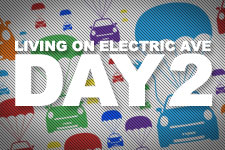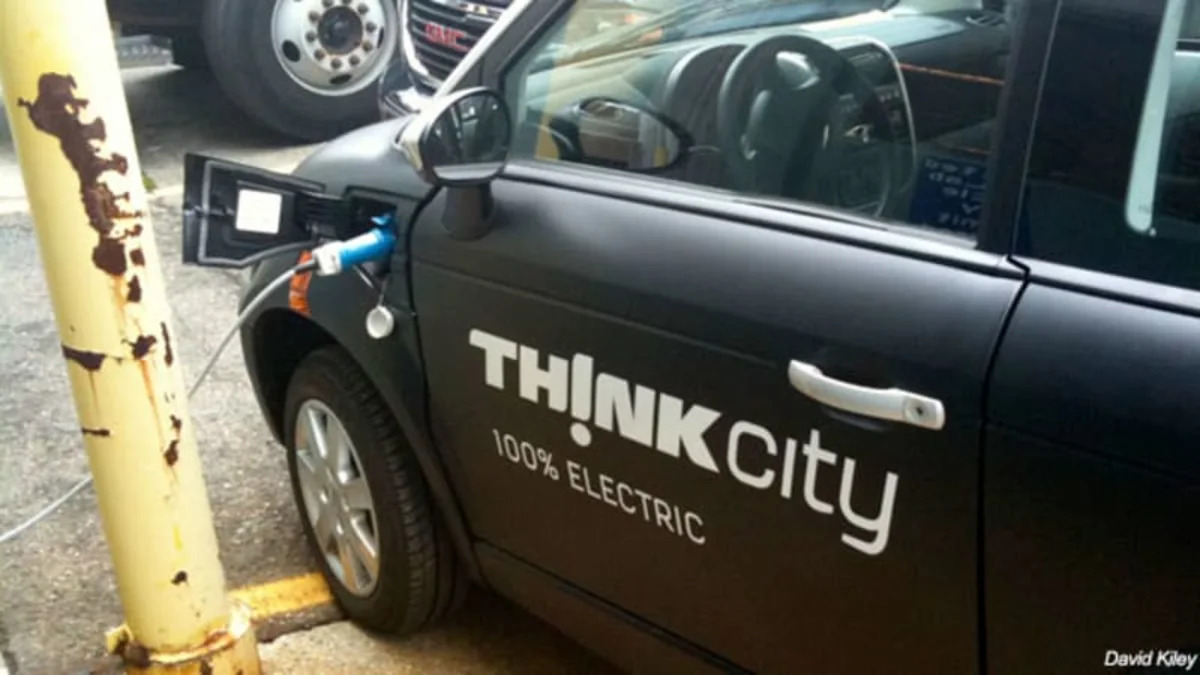 Driving an electric vehicle elicits a lot of opinions from people -- not unlike discussing politics or religion. On my second day with the Think City I attended a press conference and my weeklong project spurred a discussion with an auto analyst and fellow reporter about the money the U.S. has spent fighting wars in the Middle East. To many people, the Iraq wars have been all about securing a supply of oil from a part of the world that historically doesn't like the U.S. very much. It was a heated a discussion, at times hotter than the 90-degree sunshine beating down on us, and at one point the argument actually morphed into a debate over a woman's right to choose. Seriously. The whole chat was off the hook and it all started by discussing whether EV technology is a smart road for the auto industry to be going down.
Driving an electric vehicle elicits a lot of opinions from people -- not unlike discussing politics or religion. On my second day with the Think City I attended a press conference and my weeklong project spurred a discussion with an auto analyst and fellow reporter about the money the U.S. has spent fighting wars in the Middle East. To many people, the Iraq wars have been all about securing a supply of oil from a part of the world that historically doesn't like the U.S. very much. It was a heated a discussion, at times hotter than the 90-degree sunshine beating down on us, and at one point the argument actually morphed into a debate over a woman's right to choose. Seriously. The whole chat was off the hook and it all started by discussing whether EV technology is a smart road for the auto industry to be going down.
I drove the Think City back to the University of Michigan to recharge and meet with Huei Peng, a professor of mechanical engineering and executive director of Interdisciplinary and Professional Engineering Programs. Peng is deep into electric vehicles, training engineers and service providers for the coming EV onslaught, so his first comment is shocking.
"Electric vehicles are not ready for consumers yet, and most people know that," he said, matter-of-factly.
"Huh? But I'm driving one," I said. "And you are training people to work on them."
But Peng is persuasive, explaining that no one really immersed in the business of EVs is talking much about battery cost right now. If they did, he says, the accountants would never let an automaker build the first EV. That was the argument at GM when it killed the EV1 electric car program after it lost huge money. Peng says no one today can build a drivable EV worth owning with a range of 100 miles or more for less than $17,000 just for the battery and the "pack" of sensors and battery management extras that go with it.
That's a problem, especially if people like me say they would only be willing pay about that much for the whole car. Here is where more politics come in. Peng says the main reasons companies and governments are pushing EV research and development are to demonstrate brand leadership, from a political desire for energy diversity, and because of a genuine public and political desire to reduce carbon emissions.
It is telling that no automaker I know of is talking about making money on EVs when profit is usually the first goal of the manufacturer. The companies set to make money are the battery companies, and anyone else who can get a piece of the billions in loan and grant subsidy coming from the U.S. Department of Energy for EVs. Nissan, for example, says it plans to be the sales leader in EVs, and reports it has more than 10,000 orders for the Nissan Leaf before consumers have even test-driven the car. Nissan hasn't been a leader in anything in all it's years selling cars and trucks in the U.S.: Not price, not design, not fuel economy. But it sees an opening to become the leader in selling electric transportation. Executives hope the EV publicity and exposure will cast a better light on the brand, and the other products in the showroom. That's what happened to Toyota when it launched the Prius hybrid in the late 1990s.
As I spot my parking space at the University next to the 220-volt electrical cable, I notice that there are trucks parked on either side. This is trouble because I have to parallel park the car so that the cable will reach the charging port on the driver's side. I size up the space, and the 10-foot, 10-inch length of the Think (a good six feet shorter than my minivan), and make my move. Indeed, the car is so short that I back in and a couple three-point-turns later, I have sidled the Think into the space sideways -- a standard parking space that was meant to drive into headfirst.
Having to recharge at the University is becoming a pain. I'm thinking I should have sprung for the 220-volt charger in my garage. If I had my own cable, which I would have if I owned the car, I would treat it like my cell-phone. Use it during the day, watch the juice, and plug it in when I get home to top up the charge. There is only one problem with this approach. Batteries wear out faster the more times you charge them. Manufacturers say the best move is to run them down to between 5% and 10%, and then recharge. This is doable if you are sure to be driving under 100 miles per day. But there are going to be those days when you are down to a 50% charge, but want to drive 85 miles round trip. That kind of constant recharging could shorten the life of the battery, and thus the car. You can get a new battery down the road, the theory goes, but that might cost $10,000 or more, a questionable expense for a car that could be seven years old by that point.
A skeptical friend of mine asked me how I liked the EV today. I said, "So far, it is interesting. I like driving gas free when I can, but I am missing having an air conditioner."
"No AC?," he asked incredulously, as the sweat dripped off our noses. "I'm getting into my fully air-conditioned Jaguar now, thank you very much."
He's not a believer. Yet.
Click the links below to read about our experience Living On Electric Avenue
 Living on Electric Avenue
Living on Electric Avenue Go to: Intro Day: [1] [2] [3] [4] [5]


Sign in to post
Please sign in to leave a comment.
Continue